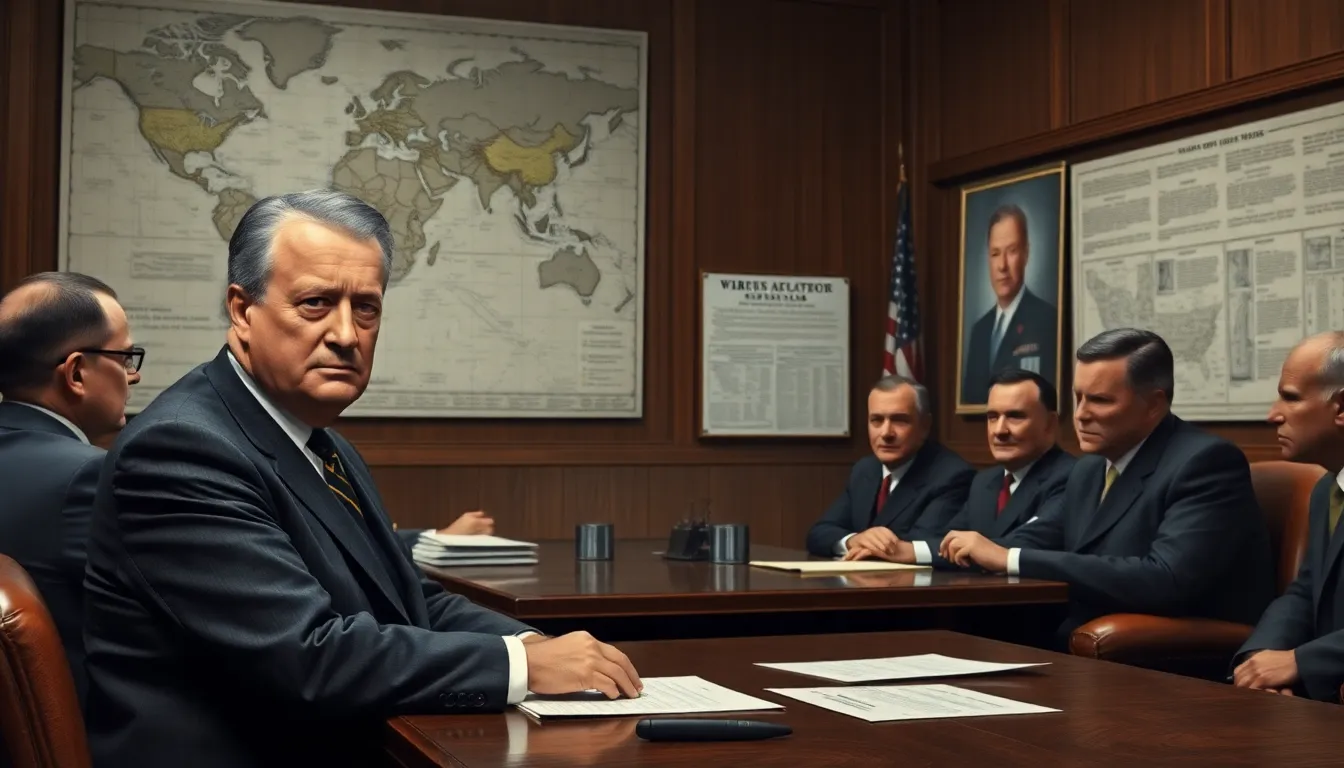World War II marked a significant turning point in global history, defined by the fierce struggle between two major coalitions: the Allied Powers and the Axis Powers. This monumental conflict, which lasted from 1939 to 1945, reshaped nations and ideologies, leaving a lasting impact on the world. The Allies, led by the United States, the Soviet Union, and the United Kingdom, united against the totalitarian regimes of Germany, Italy, and Japan, known as the Axis.
Understanding the dynamics between these two factions is crucial for grasping the complexities of the war. Each side brought unique strategies, resources, and motivations to the battlefield, influencing the course of history. This exploration delves into the origins, key players, and pivotal moments that defined the relationships and rivalries in this epic struggle, offering a clearer view of how these alliances shaped the modern world.
Table of Contents
ToggleOverview of World War II
World War II represents a significant chapter in global history, unfolding from 1939 to 1945. This conflict saw two primary factions: the Allied Powers and the Axis Powers. The Allied Powers included the United States, the Soviet Union, and the United Kingdom, united in their efforts to halt Axis expansion. The Axis Powers comprised Germany, Italy, and Japan, pursuing aggressive territorial ambitions.
The war’s origins trace back to unresolved issues from World War I and the interwar period. Economic instability, nationalistic fervor, and the rise of totalitarian regimes contributed to the tensions that ignited the conflict. Germany, under Adolf Hitler, aimed to establish dominance in Europe, while Japan sought to expand its empire across Asia.
Key events shaped the trajectory of World War II. The invasion of Poland in September 1939 by Germany triggered the involvement of Britain and France. Notable battles, such as the Battle of Britain in 1940 and the Battle of Stalingrad from 1942 to 1943, marked turning points that shifted the momentum in favor of the Allies.
The dynamics among the Allied and Axis Powers evolved throughout the war. Strategic alliances formed and shifted based on military successes and failures. The use of advanced technology, including aircraft and tanks, played a crucial role in determining outcomes on various fronts.
Additionally, the war prompted significant social changes. Women’s roles in the workforce expanded as men enlisted, while propaganda efforts mobilized public support for the war effort. The Holocaust and other war crimes committed by Axis Powers highlighted the human cost of conflict and left lasting scars on societies.
The culmination of World War II occurred with the unconditional surrender of Axis Powers in 1945. This moment transformed the geopolitical landscape, leading to the establishment of the United Nations and the onset of the Cold War, thereby influencing global relations for decades.
Allied Powers

The Allied Powers united against the Axis Powers during World War II, seeking to restore peace and freedom globally. Their collective strength and resources played a crucial role in shifting the war’s dynamics.
Major Countries Involved
- United States: Entered the war after the attack on Pearl Harbor in December 1941, providing essential military and economic support.
- Soviet Union: Joined the Allies following Germany’s invasion in June 1941, contributing significant military resources and manpower on the Eastern Front.
- United Kingdom: Engaged in the conflict from the outset, demonstrating resilience during the Battle of Britain and maintaining leadership within the Allied coalition.
- China: Fought Japan since 1937, aligning with the Allies to combat Axis aggression in Asia, enduring vast human and material losses.
- France: Initially centralized the opposition against Axis forces until its fall in 1940; Free French Forces continued fighting alongside the Allies.
Key Leaders
- Franklin D. Roosevelt: Served as the U.S. President, advocating for international cooperation and providing critical leadership throughout the war.
- Winston Churchill: The British Prime Minister, known for his defiant speeches and determination to resist Nazi aggression.
- Joseph Stalin: The leader of the Soviet Union, focused on the defense of his country while forging alliances with Western powers against the Axis.
- Chiang Kai-shek: The leader of China, worked to unify Chinese resistance against Japanese incursions and secured support from the United States.
- Charles de Gaulle: Led the Free French Forces, promoting the French cause and striving to restore France’s sovereignty post-occupation.
Strategies and Goals
- Defeat of Axis Powers: The primary goal centered around the unconditional surrender of Axis nations to prevent future threats.
- Coordinated Military Campaigns: Plans like Operation Overlord aimed at enabling cross-channel invasions to regain European territories, particularly in Normandy.
- Economic Mobilization: Nations streamlined production efforts, focusing on wartime supplies, technology development, and logistics to sustain military campaigns.
- Political Collaboration: Leaders held conferences (e.g., Yalta and Potsdam) to coordinate strategies and post-war plans, establishing a foundation for a new world order.
- Promotion of Human Rights: Allied discourse increasingly emphasized democracy and human rights, which shaped post-war governance and international relations.
Axis Powers
The Axis Powers were a coalition of nations that opposed the Allied Powers during World War II. Key members included Germany, Italy, and Japan, each with distinct motivations and objectives.
Major Countries Involved
- Germany
Germany, led by Adolf Hitler, aimed to expand its territory and establish a dominant position in Europe. The Nazi regime sought to overturn the Treaty of Versailles and promote Aryan supremacy.
- Italy
Italy, under Benito Mussolini, sought to recreate a Roman Empire, emphasizing territorial expansion in Africa and the Mediterranean. Mussolini aligned Italy with Hitler, driven by a desire for military prestige.
- Japan
Japan focused on territorial expansion in Asia and the Pacific. The government pursued imperial ambitions, seeking resources to fuel its industry and military. The attack on Pearl Harbor in December 1941 marked Japan’s entry into a broader conflict with the Allies.
Key Leaders
- Adolf Hitler
As the Führer of Nazi Germany, Hitler’s aggressive policies and militaristic ideals instigated the war. He orchestrated the invasion of Poland, which triggered the conflict in Europe.
- Benito Mussolini
Mussolini, Italy’s dictator, supported Hitler’s ambitions while promoting fascism in Italy. His involvement contributed to the Axis’s military strategies, although Italy’s performance in the war was mixed.
- Hideki Tojo
Tojo served as Japan’s Prime Minister and military leader, advocating for aggressive expansion. His leadership included the attack on Pearl Harbor, significantly escalating the war against the Allies.
Strategies and Goals
- Expansionism
The Axis Powers aimed for territorial expansion to secure resources and dominance. Germany’s Blitzkrieg strategy relied on rapid movement and surprise attacks to overwhelm opponents.
- Military Alliances
The Axis nations formed alliances to coordinate military efforts. The Tripartite Pact in 1940 formalized collaboration among Germany, Italy, and Japan, enhancing their military capabilities.
- Ideological Goals
The Axis pursued ideological aims, including fascism in Italy and Nazism in Germany. Each country’s leadership promoted a vision of racial superiority and national revival, influencing their wartime strategies.
Impact on the War
The interactions between the Allied and Axis Powers significantly influenced the course and conclusion of World War II. Understanding the major battles and the subsequent outcomes reveals how these factions shaped global history.
Major Battles and Conflicts
Key battles played a pivotal role in determining the war’s trajectory.
- Battle of Stalingrad (1942-1943): This battle marked a major turning point. The Soviet Union halted the German advance, inflicting heavy losses on the Wehrmacht.
- Battle of El Alamein (1942): Allied forces, including British troops, defeated Axis forces in North Africa. This victory prevented Axis control of the Suez Canal.
- D-Day (1944): The Allied invasion of Normandy established a crucial foothold in Europe. It led to the liberation of France and opened a new front against Germany.
- Battle of Midway (1942): The United States decisively defeated Japan, shifting the balance of power in the Pacific. This victory halted Japanese expansion.
These battles exemplified the strategic tactics employed by both sides, demonstrating how military engagement directly influenced the war’s outcome.
Outcomes and Consequences
The war’s conclusion brought significant global changes.
- Collapse of the Axis Powers: The unconditional surrender of Germany in May 1945 and Japan in September 1945 effectively ended the conflict, dismantling the Axis coalition.
- Creation of the United Nations: Established in 1945, the UN aimed to foster international cooperation and prevent future conflicts.
- Geopolitical Realignments: The post-war period saw the emergence of the Cold War, as the United States and the Soviet Union became superpowers, polarizing global politics.
- Decolonization: The war accelerated decolonization movements globally, as former colonies sought independence, leading to a wave of new nations.
The alliances formed and the battles fought during World War II reshaped national boundaries, dictated political ideologies, and changed international relations for decades to follow.
Legacy of the Allied and Axis Powers
The legacy of the Allied and Axis Powers shapes contemporary global dynamics and politics. The conclusion of World War II marked the decline of imperialism and the emergence of decolonization movements. Many nations in Asia, Africa, and the Middle East gained independence from colonial rule, redefining global power structures.
The establishment of the United Nations in 1945 aimed to promote international cooperation and prevent future conflicts. It facilitated dialogue among nations and provided a platform for addressing global issues, significantly influenced by the lessons learned during the war. The formation of NATO in 1949 further solidified the alliances formed during World War II, offering a collective defense strategy against potential aggressors.
The ideological battle that emerged during the war laid the groundwork for the Cold War. The rivalry between the US and the Soviet Union resulted in competing global ideologies—capitalism versus communism. This schism influenced international relations, military strategies, and proxy wars throughout the latter half of the 20th century.
Technological advancements from the war, such as radar, jet aircraft, and nuclear technology, had lasting impacts on military and civilian sectors. Innovations in medicine, including antibiotics and medical technologies, improved healthcare and saved countless lives in the post-war era.
Culturally, the war’s aftermath fostered an awareness of human rights violations, contributing to the development of conventions and treaties aimed at protecting individual rights. The Nuremberg Trials underscored accountability for war crimes and set precedents for international law.
The social changes, particularly the increased participation of women in the workforce during the war, altered gender roles and expectations in many societies. This shift gradually influenced movements for gender equality and women’s rights globally.
Understanding the legacies of the Allied and Axis Powers offers insight into the roots of contemporary global issues, highlighting how historical alliances, conflicts, and decisions continue to resonate in modern society.
The conflict between the Allied and Axis Powers during World War II reshaped the global landscape in profound ways. The war not only ended imperialism but also sparked movements for decolonization and set the foundation for international cooperation through the United Nations.
As nations navigated the aftermath of the war, the ideological divide between capitalism and communism emerged, leading to the Cold War and influencing decades of international relations.
Technological advancements and significant social changes, particularly the role of women in the workforce, left a lasting legacy that continues to resonate today. Understanding these dynamics offers valuable insights into contemporary global issues and highlights the importance of historical alliances and conflicts in shaping the modern world.







